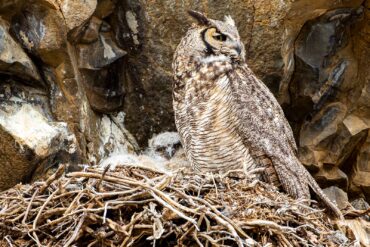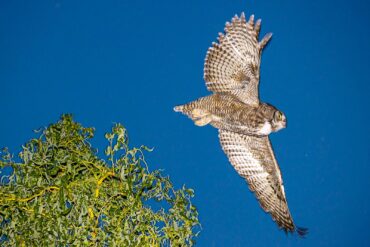
Life is a competition. Whether we realize it or not, we are always competing with someone for a job, a home purchase or a parking space, to name a few. Even birders are constantly vying with each other for top birder status.
It’s no different in the natural world, where competition among species is literally a matter of life and death. Those who win live and those who lose die.
While most of us don’t think of songbirds as predators, the insects and worms they consume would say otherwise. The songbirds themselves have to watch out for hawks and falcons that may be eyeing them for a snack. As the hawks and falcons happily consume their feathered prey, they, too, must be on alert for an even greater danger. An apex predator could make another raptor its next meal and thus makes its living at the top of the food chain.
As its name suggests, the great horned owl is a formidable bird. Named for the tufts of feathers on the top of its head that resemble horns, the great horned owl would seem inappropriately named if it were simply called the “common tufted owl.”
Not all owls hoot, but the great horned owl is the quintessential hooting owl. Movies and television shows often depict its calls to enhance night scenes.
One of the most common owls of North America, the great horned owl has a range that extends across much of the continent, from the tropics to the edge of the Arctic. It’s also found in parts of South America.

From wetlands to deserts, grasslands to forests, and city parks to wilderness, this nonmigratory owl makes its home in a variety of habitats, but is most often found in open woodlands.
The great horned owl is one of the world’s largest owls. Like most raptors, females are larger than males. The female weighs up to 3.5 pounds, while the male typically weighs 2.7 pounds.
On average, the great horned owl has a 4-foot wingspan. The male has a larger voice box, giving it a deeper voice than the female and making it audibly noticeable during hooting duets.
Cryptically camouflaged in brown and white tones, the great horned owl can perch in a tree or on the ground without being noticed. Its penetrating, yellow eyes are fixed in the sockets. Therefore, the great horned owl can swivel its head up to 270 degrees to better view its surroundings.
The world is a smorgasbord for a great horned owl. This bird usually eats small mammals and birds, but anything it can grab, even prey that is larger than itself, is on the menu. This includes everything from ospreys, peregrine falcons and other owls to songbirds, rodents, frogs and lizards. It is one of the only predators of skunks. When someone smells a skunk, it may just be a great horned owl that was sprayed by a skunk before killing and consuming it! An overconfident owl might even attack a porcupine, which may not go well for either the porcupine or the bird.
Relying on exceptional vision and hearing, the great horned owl is mostly nocturnal, but occasionally hunts in the daytime. With serrated wing feathers that allow for silent flight, it can strike unsuspecting prey at any time of day. It takes 28 pounds of force to open a great horned owl’s closed talons, which can sever the spine of large prey. Even a barred owl that lets its guard down may become nothing more than a pile of feathers if a great horned owl is in the area.
Not surprising, it is often harassed by other birds of prey, corvids and songbirds while roosting. While trying to sleep, a great horned owl may endure a barrage of attacks from angry songbirds and crows.
Mated pairs are monogamous and use nests built by other species such as ravens, hawks and eagles. They also use tree cavities, rock ledges and abandoned buildings.
The female incubates the brood of two to three eggs for a month. Both parents care for the nestlings for another five or six weeks and for several months after they have fledged. Nesting duties generally begin in late winter, perhaps so juveniles have plenty of time to develop their hunting skills before their first winter.
Even life at the top of the food chain is not without danger. The great horned owl is susceptible to poisoning by eating prey that has ingested rodenticide. Adults are safe from predation, but eggs may be eaten by corvids and raccoons and young owls may become prey for terrestrial and aerial predators.
In the competition of life, the great horned owl is the perennial gold medalist. The pinnacle of the survival of the fittest is its favorite perch. It must surely enjoy the view.



























